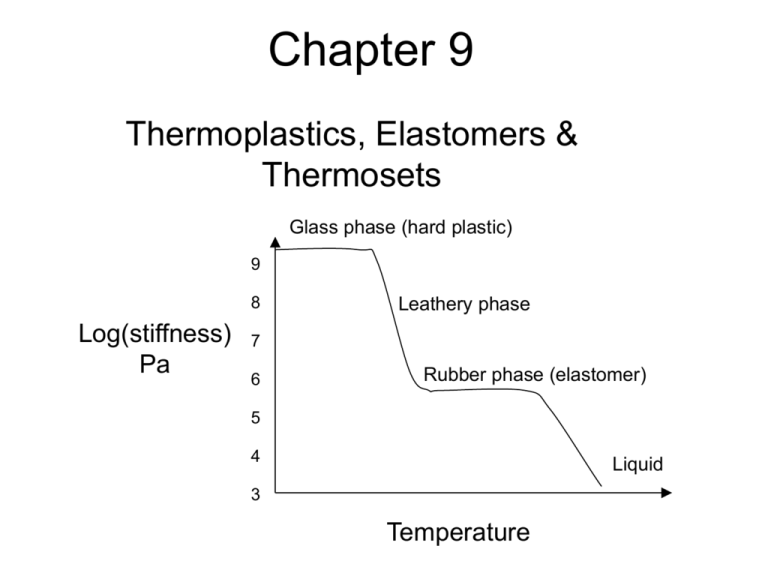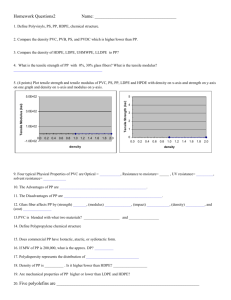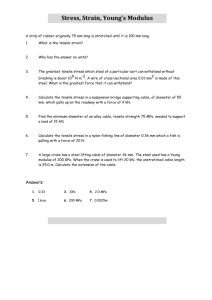Chapter 9 - Loy Research Group
advertisement

Chapter 9 Thermoplastics, Elastomers & Thermosets Glass phase (hard plastic) 9 8 Log(stiffness) Pa Leathery phase 7 6 Rubber phase (elastomer) 5 4 Liquid 3 Temperature Thermoplastics Polymers that are amorphous & glass or semicrystalline at operating temperature • Are melt processed then cooled into new forms • Can be re-heated and processed Reversible process Commodity Thermoplastics • Polyethylene H CH2 CH2 H n H CH2 CH H CH3 n • Polypropylene • Polystyrene H CH2 CH H n • Polyvinylchloride • Polyethylene terephthalate • Polymethyl methacrylate H CH2 CH H Cl n O H CH2 CH2 O Me H CH2 C MeO2C O O n H n Thermoplastics Glassy or Semicrystalline Polymer Heating Solidification Melted or Softened Polymer Extrusion through dies: linear products Molding: Complex shapes Linear vinyl polymers, Nylons, polyesters, polyarylenes polyimides. Polymer Melt Viscosity decreases at High Shear Newtonian Non-Newtonian Polymer chains align Polymer Processes Product Shaping / Secondary Operations EXTRUSION Final Product (pipe, profile) Shaping through die Secondary operation Fiber spinning (fibers) Cast film (overhead transparencies, Blown film (grocery bags) Preform for other molding processes Blow molding (bottles), Thermoforming (appliance liners) Compression molding (seals) Extrusion Extrusion process • most common manufacturing of plastic resin • combines pigments, additives and resin • high heat, high pressure molten mixture • pushed through die • create warm plastic for possible further “finishing” operation such as pelletizing, calendaring, or molding 10-30 second cycle time Figure ref: Process Selection, KG Swift and JD Booker, p. 64. injection molding machine Injection Molding Machine Basics Injection Molding 30,000 psi up to 200 MPa Processing Thermoplastics Rule of Thumb Amorphous: Tg + 80 °C Crystalline: Tm + 30 °C Injection Molding of thermoplastics Rule of thumb: A pressure increase of 100 MPa, is equivalent to a temperature decrease of 50 °C. Shear thinning Thermoplastic Injection Molding Temperatures Materials mold Injection pressure Viscosity 200-300 0C 50-150 0C 100 MPa 1000 Pa.s Therminology runners screw cavity gate barrel nose mold Thermal effects: solidification during filling viscous dissipation in the runners shrinking during solidification relaxation of the polymer temperature fluctuations Shark Skin Polystyrene Polyethylene Poly α-glucan Polypropylene semicrystalline n H 3C Tensile Strength: 31-41 MPa, Modulus = 1.2-1.7 Gpa Elongation 100-600% Living Hinge Compression Molding • Pre-shaped part placed directly into heated mold. • Examples: Dishes, Handles, Electrical Components, Fittings and housings Thermoplastic − Thermoforming Press (in two modes) Blanks Clamp Finished Part Oven Clamping Pressing n H 3C Thermoformed from sheet polypropylene amorphous Polyvinyl Chloride Cl n No Plasticizer: Rigid Polymer (pipe) Tensile Strength: 65 MPa, Modulus = 3.5 GPa Elongation 10% Saran Wrap, floor tiles, bottles 40 wt% Plasticizer: soft pliable (Tygon tubing) Tensile Strength: 15 MPa Elongation 400% Synthetic leather, shower curtains Amorphous Polystyrene n Commercial poly(styrene), PS, is a substantially linear, atactic polymer. Chain stiffness induced by the phenyl substituent creates a high Tg (105°C), Tensile Strength: 45 MPa, Modulus = 3.2 GPa Elongation 4% Styrofoam, molded objects such as tableware (forks, knives and spoons), trays, videocassette cases. Styrofoam, molded objects such as tableware (forks, knives and spoons), trays, videocassette cases. ABS: –High strength, dimensional stability, impact resistance –Poor UV resistance C N –Telephones, PC housing & keyboards, ... Grafted with polybutadiene Other styrenic resins HIPS SAN SMA - Styrene Maleic Anhydride ~ EPS (expandable polystyrene) 4 to 7% blowing agent, usually pentanes or butane IAPD THERMOPLASTICS RECTANGLE IMIDE MATERIALS S C I T S A L P S U O H P R O M A Key Characteristics: Very High Cost Per Pound Excellent Properties Above 400ЎF Excellent Electrical Properties Excellent Dimensional Stability Low Coefficient of Friction AMORPHOUS HIGH PERFORMANCE PLASTICS Key Characteristics High Cost High Temperature High Strength & Good Stiffness Good Chemical Resistance Transparency Hot Water & Steam Resistance Materials: Polysulfone Polyetherimide Polyethersulfone Polyarylsulfone AMORPHOUS ENGINEERING PLASTICS Key Characteristics: Moderate Cost Moderate Temperature Resistance Moderate Strength Good Impact Resistance Translucency Good Dimensional Stability Good Optical Qualities Materials: Polycarbonate Modified PPO Modified PPE Thermoplastic Urethane AMORPHOUS COMMODITY PLASTICS Key Characteristics: Low Cost Low Temperature Resistance] Low Strength Good Dimensional Stability Bond Well Typically Transparent Materials: Acrylic Polystyrene ABS PVC PETG CAB AMORPHOUS PLASTICS KEY CHARACTERISTICS: Soften Over a Broad Range Of Temperatures Easy to Thermoform Tend to Be Transparent Bond Well Using Adhesives and Solvents Prone To Stress Cracking Poor Fatigue Resistance Stuctural Applications Only (Not for Bearing & Wear) Materials: PI PAI PBI SEMI-CRYSTALLINE HIGH PERFORMACE PLASTICS Key Characteristics: High Cost High Temperature High Strength Good Electrical Properties Outstanding Chemical Resistance Low Coefficient of Friction Good Toughness Materials: PVDF PTFE ECTFE FEP PFA PPS PEEK SEMI-CRYSTALLINE ENGINEERING PLASTICS Key Characteristics: Moderate Cost Moderate Temperature Resistance Moderate Strength Good Chemical Resistance Good Bearing and Wear Properties Low Coefficient of Friction Difficult to Bond Materials: Nylon Acetal PET PBT UHMW-PE SEMI-CRYSTALLINE COMMODITY PLASTICS Key Characteristics: Low Cost Low Temperature Resistance Low Strength Excellent Chemical Resistance Low Coefficient of Friction Near Zero Moisture Absorption Very Good Electrical Properties Good Toughness Materials: Polyethylene Polypropylene Polymetnylpentene(TPX) S E M -C I R Y S T A L L I N E P L A SEMI-CRYSTALLINE PLASTICS KEY CHARACTERISTICS: S Sharp Melting Point Difficult to Thermoform T Tend to Be Opaque I Difficult To Bond Using Adhesives and Solvents Good Resistance To Stress Cracking C Good Fatigue Resistance Good For Bearing and Wear, As Well As Structural ApplicationsS International association of plastics distributors Polyethylene semicrystalline H CH2 CH2 H n n Probably most common plastic – glad bags and packing material, children’s toys – thermoplastic Simple formula: Not amorphous! Glass transition -130 to -80 C Melting point 130 C Tensile yield (strength) 25 MPa Tensile modulus (stiffness) 1 GPa (soft) Density 0.95 Polyethylene H CH2 CH2 H n n Material Density (kg/m3) Low density polyethylene (LDPE) 915-929 Medium density polyethylene (MDPE) 930-939 High density polyethylene (HDPE) 940-965 % Crystallinity 45-65 65-75 75-90 Property Shrinkage, Stiffness, Tensile strength, Hardness, Heat deflection, Chemical resistance Weatherability Impact strength, Ductility Density Increase Polyethylene H CH2 CH2 H n n Polymer MPa Tensile Strength MPa Modulus (%) Elongation LDPE 8-31 172-283 100-650 HDPE 22-31 1070-1090 10-1200 Wire coating Making Polymer Films Solvent Free Process (Free standing films) • Cast Extrusion • Blow Film Extrusion Solvent (Coating) Processes • Spincoating • Dipcoating • Liquid spray • Thermal Spray • Electrocoating calendaring Blown Film Extrusion • Film blowing is the most important method for producing Polyethylene films (about 90% of all PE film produced) • In film blowing a tubular crosssection is extruded through an annular die (usually a spiral die) and is drawn and inflated until the frost line is reached. The extruded tubular profile passes through one or two air rings to cool the material. • Most common materials: LDPE, HDPE, LLDPE Polyethylene Tg = -124 °C Tm = 137 °C Blown film process II http://www.bpf.co.uk/bpfindustry/reifenhauser_gallery.cfm Blown film process http://www.bpf.co.uk/bpfindustry/process_plastics_blown_film.cfm •Sheet & film extrusions •Cast vs. blown film Blown film is less expensive and more widely used semicrystalline Polyester films: O O O O Mylar = PETE Film n Tg = 80 °C Dacron = PETE fiber Tm = 260 °C Tensile Strength: 48-72 MPa, Modulus = 2.7-4.1 Gpa 50-300% elongation O O O Teonex = PEN Film n O Tg = 120 °C Tm = 262 °C Extrusion Blow molding In extrusion blow molding, a parison (or tubular profile) is extruded and inflated into a cavity with a specified geometry. The blown article is held inside the cavity until it is sufficiently cool. Blow Molding, Bottles • Hollow plastic parts with relatively thin walls. • Typical parts: Bottles, Bumpers, Bags, Ducting. Blow Molding Cast Film Extrusion • • In a cast film extrusion process, a thin film is extruded through a slit onto a chilled, highly polished turning roll, where it is quenched from one side. The speed of the roller controls the draw ratio and final film thickness. The film is then sent to a second roller for cooling on the other side. Finally it passes through a system of rollers and is wound onto a roll. Thicker polymer sheets can be manufactured similarly. A sheet is distinguished from a film by its thickness; by definition a sheet has a thickness exceeding 250 mm. Otherwise, it is called a film. 3 layer cast film line 1) Extruder 2) Forming section 3) Casting section 4) Winder http://www.reifenhauser.com/en/folienanlagen/p0010_flach_mod.asp#5 One side is normally microscopically smooth, while the other side contains microscopic asperities which promote adhesion of coatings and printing media. Polyester films: Mylar® polyester films have a unique combination of physical, chemical, thermal, and optical properties: • Strong, tough, brilliant, and clear. • Ease of converting: laminating, extrusion coating, embossing, metallizing, printing, punching, corrugation, dyeing, stamping or forming. • Ease of handling on high-speed equipment. • Retain mechanical properties: stiffness, strength, toughness, dimensional stability, and optical clarity, over an exceedingly wide range of temperatures. • Excellent temperature resistance. • Readily combined with other materials. • Strong tear-initiation and puncture resistance. • Excellent oil, grease, or moisture barrier resistance. • Excellent chemical resistance. semicrystalline Nylon 6,6: –Excellent wear resistance & slick surface –Poor dimensional stability & high cost –Gear, engine fan Strengths: Good Toughness & Strength Good Chemical resistance O N H H N O n Nylon 6,6 mp 265 °C Limitations: tg 50 °C Strong acidic environments Areas where moisture absorption is of concern -20% strength with humid environment Areas experiencing high operating temperatures Nylon 6: Tensile yield 76 MPa; Tensile modulus 1.4 GPa, elongation 250% Nylon 6,6: Tensile yield 80 MPa; Tensile modulus 2 GPa, elongation 200% Interchangable for most applications Nylon & Clay nanocomposites O O N H N H n Nylon-6 H N O Nylon 6,6 mp 220 °C mp 265 °C tg 50 °C tg 53 °C O N H n Nylon-11 mp 194 °C tg 44 °C n + Clay Polymer MELT BLENDING Tactoid Intercalated Intercalated Disordered Delaminated or Exfoliated Modulus vs Dispersion 5 4.5 Tensile Modulus, GPa 4 3.5 3 Nylon 30B 15A 2.5 2 1.5 1 0.5 0 0 5 10 15 20 25 30 TEM Dispersion Better barrier properties. Why? 35 40 Advanced Thermoplastics • All highly aromatic • Most common types: – Thermoplastic polyimides (TPI, PAI, PEI, PBI) – Polyetheretherketone (PEEK, and related) – Sulfone and related (PSU, PAS, PES, PPS) – Liquid crystal polymers (LCP) – Fluoropolymers (PTFE, PVDF) High Performance Thermoplastics Tensile Strength: 65 MPa ... O Polyether ether ketone (PEEK) Modulus: 3 GPa Tensile Strength: ... 75 MPa Modulus: 3.4 GPa ... ( N O O C ... S S S ... Polyphenylene sulfide (PPS) O O C O O Tensile Strength: 95 MPa Modulus: 25 GPa C N O C Polyetherimide (PEI) O ) ... n semicrystalline Teflon • PTFE – Polytetrafluoroethylene – aka Teflon long name, simple structure: • Exceptional resistance to solvents, great lubricant, nothing sticks to it! • The fluorine-carbon bonds are very strong, fluorines protect carbon backbone. • High melting point 330 C • High electrical breakdown – artificial muscle. • Technically a thermoplastic, but hard to process. • Opaque due to crystallinity Tensile Strength: 30 MPa Modulus: 410 MPa 350% elongation Amorphous “Acrylic” or Polymethyl methacrylate • Most common optical plastic - refractive index very close to glass (1.5), aka Plexiglas, Lucite • Amorphous • Full name polymethyl methacrylate (PMMA). • Also an important fiber, paint. • Glass transition 110 C • Melting point 130 C • Tensile yield 50 MPa; Tensile modulus 3 GPa • 2% elongation Major applications of PMMA include: Automotive industry - rear lamps, light fixtures Acrylic sheet - bathtubs Glazing - signs Composites - sinks, basins and bathroom fixtures. Polycarbonates • • • • Commercial polycarbonates are linear, symmetrical polymers that, due to extreme chain stiffness, do not crystallize easily from the melt and hence are amorphous. Amorphous O O O Lexan • Other polymers are as rigid, others are as transparent, but the bis-phenol A polycarbonate shown above provides these qualities at relatively low cost. • • • • Also affords good unnotched impact resistance and electrical insulating properties. Tensile yield 56 MPa; Tensile modulus 2.3 GPa >100% elongation Polycarbonates Excellent clarity Excellent toughness Good heat resistance Excellent electrical properties Intrinsic flame-retardancy Excellent strength Hot water = gradual embrittlement Crazed surface with exposure to organic solvents Common Shaping Processes for Thermoplastics TABLE 4.1. Mechanical Properties of Common Homopolymersa Compressive Tensile Properties at Break Property Strengthb Modulusb Elongation Strengthb Polymer (Mpa) (Mpa) (%) (Mpa) Polyethylene, low density Polyethylene, high density Polypropylene Poly(vinyl chloride) Polystyrene Poly(methyl methacrylate) Polytetrafluoroethylene Nylon 66 Poly(ethylene terephthalate) Polycarbonate aValues Flexural Strengthb (Mpa) Impact Strengthc (N/cm) 8.3-31 172-283 100-650 - - No break 22-31 1070-1090 10-1200 20-25 - 0.23-2.3 31-41 41-52 36-52 48-76 1170-1720 2410-4140 2280-3280 2240-3240 100-600 40-80 1.2-2.5 2-10 38-55 55-90 83-90 72-124 41-55 69-110 69-101 72-131 0.23-0.57 0.23-1.3 0.20-0.26 0.17-0.34 14-34 400-552 200-400 12 - 1.7 76-83 48-72 2760-4140 60-300 50-300 103 76-103 42-117 96-124 0.46-1.2 0.14-0.37 66 2380 110 86 93 9.1 taken from Aranoff,12a converted to SI units, and rounded off. bTo convert megapascals to pounds per square inch, multiply by 145. cIzod notched impact test (see Chap. 5). To convert newtons per centimeter to foot pounds per inch, multiply by 1.75. Unknown Polymers Add to water—Sp. Gr. 1.0 floats Add 46% Isopropanol— Sp. Gr. 0.94 sinks Add to 10% NaCl solution—Sp.Gr. 1.07 sinks floats PS Cont’d next page floats PP HDPE floats Add to Vegetable Oil—Sp. Gr. 0.92 sinks LDPE Add to 10% NaCl solution—Sp.Gr. 1.07 sinks Add to saturated NaCl—Sp. Gr. 1.36 floats Add to 25% NaCl Sp. Gr. 1.19 sinks sinks PC PETE PVC Burn test result- yellow flame Burn test result- green flame floats PMMA






